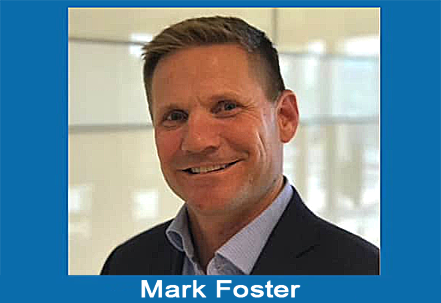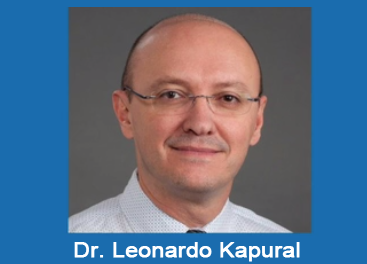 At the 2017 Orthopedic Summit (OSET) meeting in Las Vegas, Mark Foster, Trice Medical’s Chief Commercialization Officer and VP of Worldwide Sales, spoke with SmartTRAK's Kristina Meyer about the Company’s revolutionary new technology that is improving the way orthopedic injuries are diagnosed. Trice Medical’s newest product, mi-eye 2, is a fully disposable, integrated camera (the size of a 14-gauge needle) with plug-and-play technology that is FDA cleared to provide illumination and visualization during diagnostic and operative arthroscopic and endoscopic procedures. These procedures can be performed in the clinic setting and provide patients with immediate and definitive diagnoses while significantly reducing the overall cost to the healthcare system.
At the 2017 Orthopedic Summit (OSET) meeting in Las Vegas, Mark Foster, Trice Medical’s Chief Commercialization Officer and VP of Worldwide Sales, spoke with SmartTRAK's Kristina Meyer about the Company’s revolutionary new technology that is improving the way orthopedic injuries are diagnosed. Trice Medical’s newest product, mi-eye 2, is a fully disposable, integrated camera (the size of a 14-gauge needle) with plug-and-play technology that is FDA cleared to provide illumination and visualization during diagnostic and operative arthroscopic and endoscopic procedures. These procedures can be performed in the clinic setting and provide patients with immediate and definitive diagnoses while significantly reducing the overall cost to the healthcare system.
A transcript of SmartTRAK’s interview with Trice Medical is below, as is the video interview, recorded live at the 2017 OSET meeting: (11:27 min.)
SmartTRAK: We are here at the OSET meeting in Las Vegas with Mark Foster who is the Chief Commercial Officer for Trice Medical. Can you give us the background of how Trice Medical started?
Mark Foster: Trice Medical started in 2011, and really was started with surgeons and centered around the Academy meeting, looking at some patents that were on the market, and one that came to fruition was if we had the ability to look through a needle, with a camera at the end of a needle, into the body, that would be pretty cool.
There were some small patents kind of circulating. A guy by the name of Rick Washburn was put on the project, raised a little bit of money, and off we went. The first couple years were really a bit of a skunk project, getting a product and getting some prototypes to market. We had a product called the mi-eye plus which was the first iteration, and that product was really somewhat of a limited launch to see, just look at the feasibility around putting a needle with optics in an office.
Really mi-eye 2 is what we launched in March last year at the Academy. That is what we'll call the market ready product. We've raised about $41 million to date, and the bulk of the fund raise was really to commercialize that product that we launched in March.
And what are the indications for the mi-eye product?
MF: The mi-eye is the world's first and only fully disposable integrated camera. And it plugs into a Microsoft Surface tablet. Imagine a 14-gauge needle with optics at the end of that. So the ability to, in an office setting, look inside a knee or a shoulder joint and identify what's going on is really, really powerful.
“Imagine a 14-gauge needle with optics at the end of that. So the ability to, in an office setting, look inside a knee or a shoulder joint and identify what's going on is really, really powerful.” Mark Trice
The main indications that we've seen since launch are really threefold. One is confirming diagnosis for intraarticular disease. There were over eight million MRIs in the US last year and we think that the mi-eye has a chance to replace a lot of them. A lot of orthopedic surgeons, when that patient comes into their practice and they present with a meniscal tear or an ACL tear or cuff or instability in the shoulder pathology, they know what's going on within that patient, and we give them the opportunity to confirm that diagnosis in a really quick and effective way.
One is confirming diagnosis. The second one is there are some surgeons that love the ability to inject biologics under direct visualization. Today they have the choice to do that either blindly or perhaps with ultrasound, and we think the mi-eye really takes it that last vial, which is under direct visualization, to be able to inject through the mi-eye to see what's going on in there.
The third indication is what I'll call the surgical planning. If you've got cartilage damage and you're trying to think about the depth of damage for that patient, it gives you a lot of information that the MRI just isn't going to give you. If you're looking to determine whether a patient could have a uni or a total knee, it's a perfect opportunity to do that in an office-based setting. Those really are three main indications, confirming diagnosis, direct injections of biologics, and surgical planning.
Is the mi-eye product reimbursed?
MF: Yes. We've had great success in the US market with regard to reimbursement, and the reason is you're not fundamentally billing for a mi-eye procedure. You're doing a diagnostic arthroscopy. Diagnostic arthroscopy of the hip, shoulder, knee has been around a long time. Essentially, the mi-eye is offering you an opportunity to do that procedure in a different site of setting, by having disposable tools to do that in the office.
When performing a diagnostic arthroscopy, it's a 29870 for a knee or a 29805 for a shoulder. Physicians will do a full diagnostic arthroscopy in the office, document appropriately, and reimbursement has not been a problem here in the US.
What are the greatest successes that you're seeing so far with the product?
MF: I love physically watching the patient/physician interaction around them together developing their treatment plan. And the mi-eye offers that like nothing else does. Certainly better than an MRI or an x-ray. What typically happens is the patient has an injury. They will present to the physician. The physician will say go get an MRI. Now they'll go away for a week or so, get that MRI. The MRI charges are variable across the country, between $400 and $3,000.
Then they come back. They've taken off more time off their day. Come back in the office, get that MRI read, have another consultation with the physician. And the MRI is a great tool, but for intraarticular pathology, which is where the mi-eye works really well, is a static image. The mi-eye offers the dynamic image for that patient. The thing that I'll say was our greatest success is is watching the physician/patient interaction change in an office setting, where they are together looking at the tablet, looking at their pathology, and making decisions around how to manage their condition while live looking at the inside of their knee and looking at that cartilage as opposed to kind of staring up a wall and having the patient glaze over while looking at a black/white MRI or x-ray.
What are the biggest challenges that you think the company is facing or the product is facing?
MF: Fundamentally, you're changing a market. This is a market development activity that's not a fully developed market where every physician across the country is doing 20 of these a day and we're just trying to change them to a better product. We are building the market of in-office arthroscopy. And with that comes the challenges of building any market, which is changing physician behavior, particularly in an office setting. They've got questions. They want to know whether it's going to work, how well the image looks, whether they're going to be reimbursed appropriately for their time, and how it'll affect their flow of their office.
We've had good success on all of those situations, but just walking them through that takes time, takes change. Really I would say our biggest challenges have been the ones that you would think any time you're building a market.
Where is Trice going in the future? What's next on the horizon?
MF: Well, we're pretty excited about the future of Trice. We think within orthopedics that it's a very real scenario of having these procedures coming from a hospital setting to a surgery center, fundamentally down to the office. We think in the value proposition that we have in medicine, we're really well positioned to take advantage of that.
It's really probably the only product I've ever sold that is great for physicians, great for patients, and great for payers. And usually you can hit one or two of those, and we've got a great way to hit all three of those. We're excited about our opportunity in orthopedics. We think a lot of these procedures have a potential to shift to the office, and we plan on being on the forefront of that, with a lot of things we have in our R&D platform.
In addition, Trice Medical is not just an orthopedic company. Fundamentally, we're an optic company with a really easy to use device at a cost effective price point that plugs into a Microsoft Surface tablet. When you look across some of the other procedures that are moving into an office setting, whether that be in gynecology, ear, nose and throat, that space is really expanding for us.
There are a lot of different cross divisions that are interested in our technology. We've got some things evolve there. We actually just completed a deal with a very large neurovascular company to be able to use a Trice made product in the brain to remove clots for ICH patients. We look at Trice as a broad optics portfolio company with a really strong play of in-office orthopedics.
Any interest in expanding internationally?
MF: We do. We think actually internationally our value proposition might be as strong, if not stronger, and the reason being in the US, there's a lot of people that they can get an MRI, but it takes them a few days or weeks and costs a lot of money. Internationally, expand that times four or fivefold. In the Canadian system or the Israeli system for a surgeon we talk to today, it may take months in order for you to get that MRI, and those are months where patients aren't getting answers to their problems and aren't getting to surgery or getting into rehab at the right way.
Additionally, the Trice Tower, if you will, is a tower in a backpack. It's a battery operated arthroscopy tower. There are some parts of the underdeveloped world where physicians are coming to us saying I can take this product, put it in my backpack, and go out and actually treat patients in some of these communities that don't have access to arthroscopy towers in every corner. We're very excited about our international expansion plans, as well.
Lastly, what's the biggest thing that you would like people to know about Trice?
MF: I think it's important, particularly at this meeting, which is really where some of the world's leading orthopedic surgeons are, it's important for that community to know that this product is not just a tool for ease of use. This is a product that can really deliver clinical answers to their patients that they don't get.
When you think about some of the surgeons that are here, they're at the tertiary centers that are getting the second and third referrals on patients that have had multiple surgeries. Those patients, if you're doing a rotator cuff or instability for the second or third time on a patient, that MRI is not going to give you a lot of good information.
If you're looking to do a cartilage restoration, again the MRI is going to give you some of the information. We think Trice is really a clinical tool to help them surgically plan their procedures. We really want to make sure people understand that this is a tool that every orthopedic surgeon should have in their bag.
We had a surgeon last week tell me that there's no way an orthopedic surgeon in today's world shouldn't know how to do office arthroscopy. MRIs are not going to be accessible. They're going to have a harder time getting them approved. This is just a skill set that they need to know how to do, and they're going to kind of work through the learning curve, do 10 in an office, and then be able to use it appropriately as needed.
We're also really excited about some of the other indications outside of sports. We have traumatologists coming to us, looking at doing tibial plateau reductions, as well as some ankle work, as well as the recon doctors looking at using the tool for unis versus total knees.
I think that's probably the main thing we want everybody to know is that this is a really high-end clinical tool that they can use to help their patients.
Thanks so much, Mark.
MF: Thank you.





.png)
